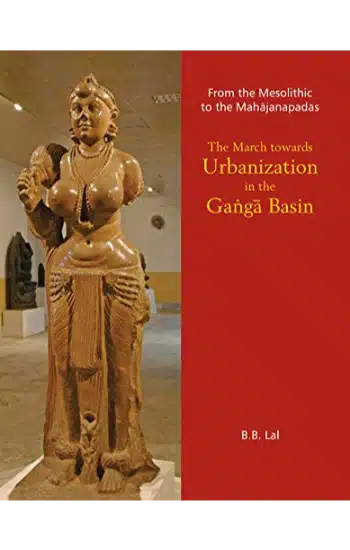FROM THE MESOLITHIC TO THE MAHAJANAPADAS: THE MARCH TOWARDS URBANIZATION IN THE GANGA BASIN
Publisher:
| Author:
| Language:
| Format:
Publisher:
Author:
Language:
Format:
₹2,950 ₹2,508
Save: 15%
In stock
Ships within:
In stock
| Book Type |
|---|
ISBN:
Page Extent:
The 6th-5th centuries before the Common Era witnessed an outburst of urbanization in the Ganga Basin. Cities sprang up with houses built of kiln-fired bricks and oriented along the cardinal directions. Sanitation was taken due care of, with soakage jars, ‘ring wells’ and public drains. Water-supply was ensured by constructing wells and reservoirs.
Surplus agricultural produce and storage thereof in granaries testified to basic economic health. Trade was in full swing and there were long-distance trade-routes, such as Uttarapatha and Daksinapatha. Systems of weights and coinage emerged and that of writing was not left behind.
All this coincided with the emergence of Sodasa Mahajanapadas (Sixteen Big States), which throws light on the contemporary political set-up. Matrimonial alliances on the one hand and wars on the other became common features. A striking point about the Ganga Civilization is that whereas the Harappan Civilization was confined to the north-western part of India, this civilization covered the entire sub-continent -from Pakistan to Bangladesh and down south even to Sri Lanka.
But, as they say, ‘Rome was not built in a day’. It took four millennia for the Ganga Civilization to evolve from a Neolithic base in the 4th millennium BCE. On this foundation impinged a chalcolithic culture, followed by the emergence of iron. Signs of an incipient urbanization began to appear with the Painted Grey Ware Culture towards the end of 2nd millennium BCE. The book deals with this ‘march towards urbanization’ in the Ganga basin.
The 6th-5th centuries before the Common Era witnessed an outburst of urbanization in the Ganga Basin. Cities sprang up with houses built of kiln-fired bricks and oriented along the cardinal directions. Sanitation was taken due care of, with soakage jars, ‘ring wells’ and public drains. Water-supply was ensured by constructing wells and reservoirs.
Surplus agricultural produce and storage thereof in granaries testified to basic economic health. Trade was in full swing and there were long-distance trade-routes, such as Uttarapatha and Daksinapatha. Systems of weights and coinage emerged and that of writing was not left behind.
All this coincided with the emergence of Sodasa Mahajanapadas (Sixteen Big States), which throws light on the contemporary political set-up. Matrimonial alliances on the one hand and wars on the other became common features. A striking point about the Ganga Civilization is that whereas the Harappan Civilization was confined to the north-western part of India, this civilization covered the entire sub-continent -from Pakistan to Bangladesh and down south even to Sri Lanka.
But, as they say, ‘Rome was not built in a day’. It took four millennia for the Ganga Civilization to evolve from a Neolithic base in the 4th millennium BCE. On this foundation impinged a chalcolithic culture, followed by the emergence of iron. Signs of an incipient urbanization began to appear with the Painted Grey Ware Culture towards the end of 2nd millennium BCE. The book deals with this ‘march towards urbanization’ in the Ganga basin.
About Author
Reviews
There are no reviews yet.
Related products
Vishwas Patil Set Of 2 Books : Sambhaji | Panipat
Save: 45%
History of Medieaval Hindu India: Rise of Hindu Kingdom
Save: 25%
History of Medieaval Hindu India: Rise of Hindu Kingdom
Save: 15%
RELATED PRODUCTS
Tipu Sultan The Saga of Mysore’s Interregnum (1760–1799)
Save: 40%
A History of the Mahrattas (3 Vols. Set) (Hardback)
Save: 30%
A History of the Mahrattas (3 Vols. Set) (Paperback)
Save: 30%
Alwan-E-Nemat: A journey through Jahangir’s kitchen
Save: 40%
History of Medieaval Hindu India: Rise of Hindu Kingdom
Save: 25%
History of Suffism in India: 2 (A History of Suffism in India)
Save: 5%
The Economic History of India Under Early British Rule
Save: 5%
The Marathas 1600–1818 (The New Cambridge History of India)
Save: 10%
Vishwas Patil Set Of 2 Books : Sambhaji | Panipat
Save: 45%




Reviews
There are no reviews yet.